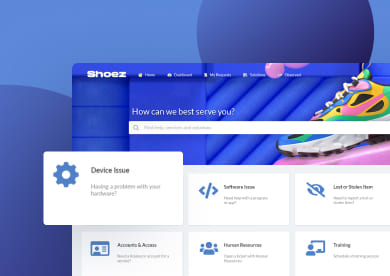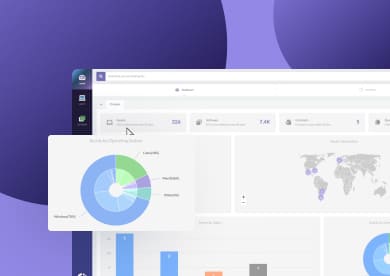Enterprise Asset Management (EAM) is the practice of overseeing an organization’s assets throughout their entire lifecycle to maximize value, reduce risks, and align them with business goals.
Its importance is clear, yet adoption is uneven. According to the 2023 IFS Enterprise Asset Management Trend Report, 15% of organizations are still stuck at a “reactive” stage of EAM maturity, waiting until equipment fails before taking action.
In this article, we’ll break down what EAM really means, what assets fall under its scope, and why it’s critical for modern organizations. We’ll also explore the processes, software, examples, and best practices that can help you put EAM into action.
What is Enterprise Asset Management?
Enterprise Asset Management is a discipline and framework for managing the lifecycle of an organization’s physical assets across the enterprise.
It’s enabled by a set of processes and usually supported by specialized software platforms that integrate data, optimize performance, and align asset decisions with business strategy.
What is an asset in EAM?
In Enterprise Asset Management, an asset is any resource that supports the delivery of products or services and requires investment, maintenance, and oversight throughout its lifecycle. Common categories include:
- Facilities and infrastructure — buildings, warehouses, plants, offices, and utilities.
- Production equipment — machinery, tools, assembly lines, industrial robots.
- Transportation and fleets — vehicles, rail assets, aircraft, shipping containers.
- Linear assets — pipelines, power lines, railways, and roads.
- Energy and utilities assets — turbines, generators, grids, and distribution networks.
- Healthcare and lab equipment — imaging machines, surgical devices, monitoring tools.
- IT assets — computers, servers, networks, IoT devices, software licenses, and sometimes even intangible assets like patents or trademarks.
In EAM, the definition of "asset" is intentionally broad. If it represents value, involves risk, and needs to be managed across its lifecycle, it falls under the scope of EAM.
Why is Enterprise Asset Management important?
Enterprise Asset Management is important because it directly impacts an organization’s profitability, resilience, and long-term competitiveness.
Assets represent some of the most significant investments companies make, and poor management of them leads to wasted capital, unplanned downtime, compliance risks, and even safety hazards.
By adopting a cohesive EAM strategy, organizations ensure that every asset contributes to business goals, generates maximum return on investment, and operates safely and reliably.
Key benefits of EAM systems
- Cost savings and ROI – extend asset life, avoid unnecessary purchases, and make smarter investment decisions.
- Operational efficiency – reduce downtime and delays by scheduling proactive maintenance and automating workflows.
- Risk and Compliance Management – stay ahead of safety, regulatory, and cybersecurity requirements to minimize liability.
- Data-driven decision-making – leverage real-time insights, predictive analytics, and digital twins to optimize asset strategies.
- Collaboration and visibility – break down silos by centralizing asset information and aligning multiple departments around shared goals.
How does an Enterprise Asset Management system work?
An Enterprise Asset Management system works by combining people, processes, and technology into a unified framework that oversees assets across their entire lifecycle. It aligns strategic planning with day-to-day operations, making sure that every asset is properly tracked, maintained, and optimized.
In other words, EAM systems work by transforming Asset Management from a set of isolated activities into a cohesive, enterprise-wide practice that maximizes asset value, ensures compliance, and supports long-term business goals.
What is Enterprise Asset Management software?
A key part of any Enterprise Asset Management system is the software that supports it. While there are many platforms marketed as Enterprise Asset Management software, some organizations also use broader tools (like ERP or IT Asset Management software ) that can extend to EAM practices.
The important thing is not to juggle multiple disconnected tools, but to aim for a single source of truth that gives you full visibility and management over your entire asset ecosystem.
Rather than thinking in terms of brand names or "which Enterprise Asset Management solution to choose," managers should focus on the features that make true EAM possible.
5 key features of effective EAM software
- End-to-end Lifecycle Management - Manage assets from planning and procurement all the way through maintenance and eventual disposal, ensuring no stage is overlooked.
- Work order and Maintenance Management - Streamline preventive, corrective, and predictive maintenance with centralized work orders, scheduling, and automated assignments.
- Data and analytics - Use real-time monitoring, dashboards, and predictive analytics to anticipate issues, reduce downtime, and make data-driven decisions.
- Compliance and Risk Management - Track safety, regulatory, and governance requirements while keeping clear audit trails and documentation for accountability.
- Integration and mobility - Connect with ERP, supply chain, and IoT systems while giving technicians mobile access to update asset data, complete tasks, and collaborate in the field.
The Enterprise Asset Management process
Implementing Enterprise Asset Management is not just about installing software. It’s about creating a structured approach that combines people, processes, and technology.
While every organization will adapt the process to its own context, a typical EAM journey includes these stages:
- Define objectives and scope - Start by identifying what you want EAM to accomplish: cost control, compliance, risk reduction, or lifecycle optimization. Set clear KPIs and decide which asset categories and departments will be included.
- Prepare and consolidate data - Collect existing asset information from spreadsheets, ERPs, or siloed systems. Standardize formats, eliminate duplicates, and fill in missing data. Clean and reliable asset data is the foundation of any EAM initiative.
- Design roles and responsibilities - Establish who owns which assets, who approves maintenance or procurement decisions, and how departments will collaborate. Clear governance avoids overlaps and blind spots.
- Select and configure the EAM software - Choose a platform that can serve as your single source of truth. Configure workflows, permissions, and integrations with existing systems (ERP, supply chain, ITAM, etc.).
- Deploy and train - Roll out the system in phases, starting with high-value or high-risk assets. Train users across maintenance, finance, and operations so they understand both the software and the underlying processes.
- Monitor and refine - Once live, track results against your KPIs. Adjust workflows, automate repetitive tasks, and gradually introduce advanced capabilities like IoT sensors, predictive analytics, or digital twins to increase maturity.
4 EAM examples
- Manufacturing plant - An automotive company uses EAM to predict when assembly line robots need maintenance, schedule downtime in advance, and ensure spare parts are ready — cutting outages and extending machine life.
- Utilities provider - An energy firm manages power stations and transmission lines with EAM, giving field workers mobile access to maps, sensor data, and work orders. This helps detect issues early, boost safety, and lower maintenance costs.
- Healthcare organization - A hospital applies EAM to track and service medical equipment like MRI machines and surgical tools. Predictive alerts prevent failures, while finance teams use the same system for smarter replacement planning.
- IT and digital infrastructure - A financial services company uses EAM to manage servers, networks, and cloud resources. The system tracks asset health, automates patching and upgrades, and flags when equipment nears end-of-life.
3 consequences of poor Enterprise Asset Management
When organizations neglect Enterprise Asset Management, the impact goes far beyond inefficient maintenance. Without a structured approach, assets become liabilities instead of drivers of value. Here are three major consequences of poor EAM:
- Unplanned downtime and higher costs - Without proactive maintenance, assets fail unexpectedly. This leads to production stops, emergency repairs, and costly replacements that could have been avoided.
- Compliance and safety risks - Poorly managed assets make it harder to meet regulatory standards and safety requirements. This can result in audits, fines, accidents, or reputational damage.
- Shortened asset lifespan and wasted investments - Assets that aren’t tracked or optimized wear out faster, forcing organizations to reinvest sooner than planned and eroding return on investment.
Using InvGate Asset Management as your Enterprise Asset Management tool

While Enterprise Asset Management is a broad discipline that spans facilities, fleets, industrial machinery, and more, a key enabler is having the right platform to centralize information and connect processes. This is where InvGate Asset Management comes in.
InvGate Asset Management is designed to give organizations a single source of truth for all their assets, but its flexible structure makes it a strong foundation for broader EAM practices.
Ready to see it in action? Start your 30-day free trial of InvGate Asset Management and experience how it can help you put Enterprise Asset Management into practice.
5 Enterprise Asset Management best practices
Like any business discipline, EAM delivers the most value when it’s applied with consistency and strategy. To help organizations avoid common pitfalls, here are some best practices to keep in mind:
- Define clear objectives - Start with business goals in mind — whether it’s reducing downtime, improving compliance, or maximizing ROI. Clear objectives guide every step of your EAM strategy.
- Maintain accurate and centralized data - A single source of truth is essential. Standardize asset records, eliminate duplicates, and make sure all teams are working with reliable, up-to-date information.
- Use the right technology - Choose an EAM platform or software (like InvGate Asset Management) that integrates processes, connects departments, and provides visibility across the entire asset base.
- Promote cross-department collaboration - EAM is not just an IT or maintenance responsibility. Involve finance, operations, compliance, and leadership to align asset decisions with business strategy.
- Continuously monitor and refine - Treat EAM as an ongoing practice. Track performance against KPIs, learn from results, and gradually introduce advanced capabilities like predictive analytics or IoT integration as maturity grows.















